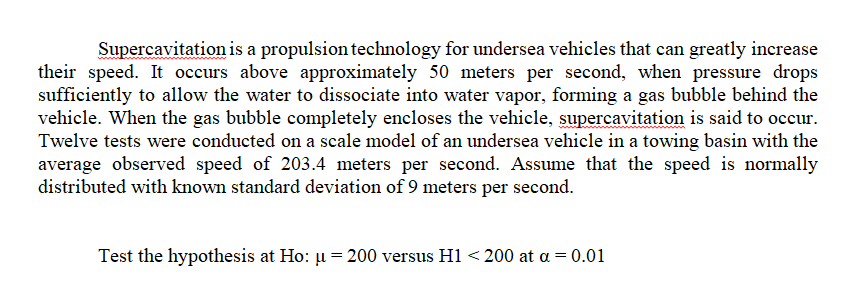Supercavitation is a propulsion technology for undersea vehicles that can greatly increase their speed. It occurs above approximately 50 meters per second, when pressure drops sufficiently to allow the water to dissociate into water vapor, forming a gas bubble behind the vehicle. When the gas bubble completely encloses the vehicle, supercavitation is said to occur. Twelve tests were conducted on a scale model of an undersea vehicle in a towing basin with the average observed speed of 203.4 meters per second. Assume that the speed is normally distributed with known standard deviation of 9 meters per second. Test the hypothesis at Ho: u = 200 versus H1<200 at a = 0.01
Supercavitation is a propulsion technology for undersea vehicles that can greatly increase their speed. It occurs above approximately 50 meters per second, when pressure drops sufficiently to allow the water to dissociate into water vapor, forming a gas bubble behind the vehicle. When the gas bubble completely encloses the vehicle, supercavitation is said to occur. Twelve tests were conducted on a scale model of an undersea vehicle in a towing basin with the average observed speed of 203.4 meters per second. Assume that the speed is normally distributed with known standard deviation of 9 meters per second. Test the hypothesis at Ho: u = 200 versus H1<200 at a = 0.01
Linear Algebra: A Modern Introduction
4th Edition
ISBN:9781285463247
Author:David Poole
Publisher:David Poole
Chapter6: Vector Spaces
Section6.7: Applications
Problem 18EQ
Related questions
Question

Transcribed Image Text:Supercavitation is a propulsion technology for undersea vehicles that can greatly increase
their speed. It occurs above approximately 50 meters per second, when pressure drops
sufficiently to allow the water to dissociate into water vapor, forming a gas bubble behind the
vehicle. When the gas bubble completely encloses the vehicle, supercavitation is said to occur.
Twelve tests were conducted on a scale model of an undersea vehicle in a towing basin with the
average observed speed of 203.4 meters per second. Assume that the speed is normally
distributed with known standard deviation of 9 meters per second.
Test the hypothesis at Ho: u = 200 versus H1<200 at a = 0.01
Expert Solution
This question has been solved!
Explore an expertly crafted, step-by-step solution for a thorough understanding of key concepts.
This is a popular solution!
Trending now
This is a popular solution!
Step by step
Solved in 2 steps with 2 images

Recommended textbooks for you

Linear Algebra: A Modern Introduction
Algebra
ISBN:
9781285463247
Author:
David Poole
Publisher:
Cengage Learning

Linear Algebra: A Modern Introduction
Algebra
ISBN:
9781285463247
Author:
David Poole
Publisher:
Cengage Learning